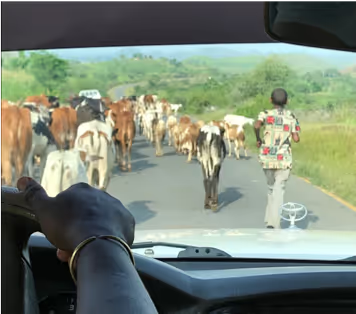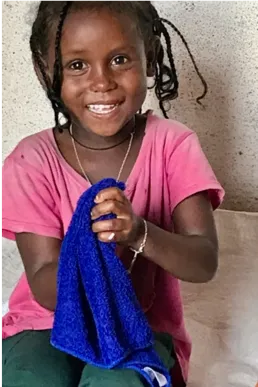In the field with the SuperTowel!

It is 7.15 am on a Wednesday morning and for the 14th time in three weeks the big Landcruiser, with Wolay, the driver, behind the wheel, makes its way from the town of Shire to an Eritrean refugee camp called Hitsats. The road conditions are extremely good, with a good and well-maintained tar-road all the way to the camp. Unfortunately, the cows, goats, sheep and camels are very fond of the good road, leading to congestions that make London rush hour traffic look like a walk in the park.
In the car is Sian White, a researcher from the London School of Hygiene and Tropical Medicine (LSHTM), Kifle Desta, our translator, comedian and by now – good friend, and myself. It is going to be my last day in the camp. Tomorrow morning I will take the flight back to Addis Ababa back to hot showers, soft beds and proper internet connections.
For three weeks we have performed extended observations in 13 households distributed 120 SuperTowels for camp residents to trial undertaken 40 follow-up visits 3 focus group discussions (FGD) (FGDs) and spoken to representatives of the Government, UN agencies and NGOs who are providing services in the camp. All of this was made possible by the incredible support we received from the Danish Refugee Council (DRC) team in Addis Ababa and in Shire.
During the first 4 days in the camp we spent the morning hours in people’s households, observing what day-to-day life was like in Hitsats camp. With the help of some of DRC’s social workers, especially Adolis, we selected households with different compositions of gender, family size, age, religion and educational background. During these observation sessions we got a taste of Eritrean hospitality and were served with traditionally prepared coffee and popcorn to such an extent that even I (a notorious caffeine addict) couldn’t take any more.
In the afternoon we distributed SuperTowels to the households we had been observing in the morning and selected a few more households to enroll in the study. Before we left the camp in the evening we selected the families that we would be observing the next day.
We then performed 3 FGDs, 1 with only men and 2 with only women. Two of the FGDs were designed to better understand people’s preferences towards handwashing products. We presented people with different soap bars ranging from the freely distributed United Nations High Commissioner for Refugees (UNHCR) soap, to expensive Lifebouy bars. Also included in the range of products were liquid soap, alcohol-based hand sanitizing gel and the Supertowel.

The other FGD was designed to understand participants' spontaneous reactions towards the Supertowel. We wanted to see if people automatically understood that the Supertowel was a product for handwashing. We gave them various picture-based instructions, to see whether people intuitively understood how to use the product and whether they would trust it based on these drawings alone.

Simultaneous with the FGDs we started the first follow up visits. Five days after we initially distributed the SuperTowels to families, we revisited them and asked a set of questions about their experiences with the product and whether there had been any problems with using it at the critical times for handwashing. We went back to each of the houses again around the 10th day and conducted another interview with household members. This time we asked another set of questions about their experiences, their recommendations about how to improve the product, and whether people would continue using the SuperTowels after we had left.
During all the follow-up visits we checked the SuperTowels for wetness, location and smell. The wetness of the SuperTowel was a good indicator of it actually being used, since people had been told that SuperTowel only will become effective if it is wet.
Conclusions and feedback
We got overwhelmingly positive feedback from the families that had been involved in the behaviour trials. The feedback can be summarised as follows:
- People found it an acceptable and appropriate solution given that they were living in a water scarce environment and had limited economic resources.
- People liked its multi-functionality. The SuperTowels were used for handwashing, body washing, cooling and even as a fly-swat.
- The SuperTowel seemed to improve handwashing frequency and ease allowing people to clean their hands at times when they might not otherwise bother (e.g. when outside the home or during food preparation).
The field study with SuperTowel in Hitsats camp will be described in more details and results summarised in a scientific paper, that will be published at a later date.
Please do not hesitate to contact Torben Holm Larsen ([email protected]) or Sian White ([email protected]) if you are interested in more information about SuperTowel and the work we are doing to develop the product and the concept.
By Torben Holm Larsen, Real Relief
Stay updated
Sign up for our newsletter to receive regular updates on resources, news, and insights like this. Don’t miss out on important information that can help you stay informed and engaged.
Related articles
.png)


Explore Elrha
Learn more about our mission, the organisations we support, and the resources we provide to drive research and innovation in humanitarian response.